Comparative Evaluation and Multi-Objective Optimization of Cold Plate Designed for the Lithium-Ion Battery Pack of an Electrical Pickup by Using Taguchi–Grey Relational Analysis
Abstract
1. Introduction
2. Materials and Methods
2.1. Testing and One-Dimensional Generic Model of the Battery
2.2. Physical Model and Used Materials of Cooling Plate
2.3. CFD Model
- The flow is steady-state, three-dimensional, and turbulent in a continuous regime.
- The properties of the solid and the fluid do not change with temperature.
- Since the working fluid is liquid, the variation of the density can be ignored. Hence, fluid can be acceptable as incompressible.
- No-slip boundary condition was used for solid–fluid boundary surfaces.
- Since the surface area of the side walls are smaller compared to the heat flux surface (horizontal surface), the adiabatic boundary condition was applied to the side walls of the solid region (cold plate).
- Channel inlets and outlets were extended by 300 mm, which is ten times the channel width. Then, homogeneous velocity distribution was taken at the extended channel entrance.
- Pressure boundary condition at the channel outlet was applied.
- Coupled interface definitions were made on these common surfaces between the cold plate and the channels, and mesh interfaces were created fluently so that the software could solve the heat transfer in these regions.
- Only the energy equation was solved in the solid part of the cold plate geometry.
- Since the geometry and conditions were symmetric with respect to the middle horizontal plane of the cold plate, the symmetry conditions were applied at those surfaces.
- As it is discussed in Section 2.2, constant heat flux boundary condition was applied at the bottom surface of the cold plate.
- The normalized residuals of the governing equations were considered for the convergence criteria. During the computations, it was accepted that the numerical simulation was converged when the normalized residuals of the continuity, momentum, and turbulence equations were less than 10−5 and the energy equation was less than 10−7.
2.4. Validation and Mesh Independence Study
2.5. Parameters Used in the Evaluation of the CFD Analysis
2.6. Taguchi-Based Grey Relation Analysis
3. Results and Discussions
3.1. General Evaluations of the Results
3.2. Taguchi-Based Grey Relation Analysis Results
3.3. Multi-Response Optimization with Taguchi–Grey Relational Analysis Method
3.4. Sensitivity Analysis of the Optimized Cold Plates
4. Conclusions
- A new empirical Nusselt number equation is proposed. It predicts Nusselt number within 5% error for all coolant fluids and cases considered in this study. In the sensitivity analysis by using only water and 25% and 50% ethylene glycol–water solutions as the coolant fluid, it shows a perfect agreement with the computed Nusselt number values for Reynolds number ranges from 2500 to 15,000.
- Water as a coolant fluid presents better thermal and hydraulic performance (i.e., smaller Tmax, Tmean, Tσ, and ∆P) than the other coolants for the same geometry and working conditions.
- It is also observed that the rise of ethylene glycol ratio in the coolant solution decreases the thermal and the hydraulic performance (i.e., larger Tmax, Tmean, Tσ, and ∆P) for the same geometry and working conditions.
- The pressure drop (∆P) is the most influenced parameter from the geometry and mass flow rate. It has significant variation from case to case for all coolant fluids.
- Increasing channel number with a constant total mass flow rate gives a more homogeneous temperature distribution (i.e., smaller Tσ) on the cold plate surface.
- In the Taguchi-based grey relational analysis, the pressure drop with the highest variation with respect to other outcome parameters has the highest weighting factor.
- In the multi-objective optimization, maximizing the number of channels in the cold plate geometry is the common choice for all coolants.
- Weighting factors showing the effect of each result parameter on cooling performance were calculated by Taguchi analysis.
- As a result of the multi-objective optimization, among the three coolant types, water gives the lowest maximum temperature, the best temperature homogeneity, and the lowest pressure drop for the same operating conditions. Meanwhile, EGW 50 coolant gives the worst performance values. It should be mentioned that ethylene glycol–water solutions have lower freezing temperatures, and they can work under sub-zero environmental conditions. It can be also used for the heating to keep the battery temperature in the working temperature range.
- The use of different cold plate designs with hybrid cooling methods for the different battery packs and the comparison of the results with experimental or numerical studies, the use of different fluids, and the effects of transient conditions may be separate research topics in the future.
Author Contributions
Funding
Institutional Review Board Statement
Informed Consent Statement
Data Availability Statement
Acknowledgments
Conflicts of Interest
References
- Burden, D.; Litman, T. America Needs Complete Streets. ITE J. 2011, 81, 36–43. [Google Scholar]
- Kennedy, C.A. A Comparison of the Sustainability of Public and Private Transportation Systems: Study of the Greater Toronto Area. Transportation 2002, 29, 459–493. [Google Scholar] [CrossRef]
- Rojas-Rueda, D.; Nieuwenhuijsen, M.J.; Khreis, H.; Frumkin, H. Autonomous Vehicles and Public Health. Annu. Rev. Public Health 2019, 41, 329–345. [Google Scholar] [CrossRef]
- Axsen, J.; Plötz, P.; Wolinetz, M. Crafting Strong, Integrated Policy Mixes for Deep CO2 Mitigation in Road Transport. Nat. Clim. Chang. 2020, 10, 809–818. [Google Scholar] [CrossRef]
- Xia, T.; Zhang, Y.; Crabb, S.; Shah, P. Cobenefits of Replacing Car Trips with Alternative Transportation: A Review of Evidence and Methodological Issues. J. Environ. Public Health 2013, 2013, 797312. [Google Scholar] [CrossRef]
- Rahman, M.M.; Alam, K.; Velayutham, E. Reduction of CO2 Emissions: The Role of Renewable Energy, Technological Innovation and Export Quality. Energy Rep. 2022, 8, 2793–2805. [Google Scholar] [CrossRef]
- Horowitz, C.A. Paris Agreement. Int. Leg. Mater. 2016, 55, 740–755. [Google Scholar] [CrossRef]
- WADA, M. Research and Development of Electric Vehicles for Clean Transportation. J. Environ. Sci. 2009, 21, 745–749. [Google Scholar] [CrossRef]
- Andersen, P.H.; Mathews, J.A.; Rask, M. Integrating Private Transport into Renewable Energy Policy: The Strategy of Creating Intelligent Recharging Grids for Electric Vehicles. Energy Policy 2009, 37, 2481–2486. [Google Scholar] [CrossRef]
- Miao, Y.; Hynan, P.; Von Jouanne, A.; Yokochi, A. Current Li-Ion Battery Technologies in Electric Vehicles and Opportunities for Advancements. Energies 2019, 12, 1074. [Google Scholar] [CrossRef]
- Wang, Q.; Jiang, B.; Li, B.; Yan, Y. A Critical Review of Thermal Management Models and Solutions of Lithium-Ion Batteries for the Development of Pure Electric Vehicles. Renew. Sustain. Energy Rev. 2016, 64, 106–128. [Google Scholar] [CrossRef]
- Chen, S.C.; Wan, C.C.; Wang, Y.Y. Thermal Analysis of Lithium-Ion Batteries. J. Power Sources 2005, 140, 111–124. [Google Scholar] [CrossRef]
- Smith, K.; Wang, C.Y. Power and Thermal Characterization of a Lithium-Ion Battery Pack for Hybrid-Electric Vehicles. J. Power Sources 2006, 160, 662–673. [Google Scholar] [CrossRef]
- Smith, J.; Hinterberger, M.; Schneider, C.; Koehler, J. Energy Savings and Increased Electric Vehicle Range through Improved Battery Thermal Management. Appl. Therm. Eng. 2016, 101, 647–656. [Google Scholar] [CrossRef]
- Choudhari, V.G.; Dhoble, D.A.S.; Sathe, T.M. A Review on Effect of Heat Generation and Various Thermal Management Systems for Lithium Ion Battery Used for Electric Vehicle. J. Energy Storage 2020, 32, 101729. [Google Scholar] [CrossRef]
- Zhao, C.; Zhang, B.; Zheng, Y.; Huang, S.; Yan, T.; Liu, X. Hybrid Battery Thermal Management System in Electrical Vehicles: A Review. Energies 2020, 13, 6257. [Google Scholar] [CrossRef]
- Lv, W.; Li, J.; Chen, M. Experimental Study on the Thermal Management Performance of a Power Battery Module with a Pulsating Heat Pipe under Different Thermal Management Strategies. Appl. Therm. Eng. 2023, 227, 120402. [Google Scholar] [CrossRef]
- Chen, J.; Kang, S.; Jiaqiang, E.; Huang, Z.; Wei, K.; Zhang, B.; Zhu, H.; Deng, Y.; Zhang, F.; Liao, G. Effects of Different Phase Change Material Thermal Management Strategies on the Cooling Performance of the Power Lithium Ion Batteries: A Review. J. Power Sources 2019, 442, 227228. [Google Scholar] [CrossRef]
- Souayfane, F.; Fardoun, F.; Biwole, P.H. Phase Change Materials (PCM) for Cooling Applications in Buildings: A Review. Energy Build. 2016, 129, 396–431. [Google Scholar] [CrossRef]
- Aslan, E.; Aydın, Y.; Yaşa, Y. Consideration of Graphene Material in PCM with Aluminum Fin Structure for Improving the Battery Cooling Performance. Int. J. Energy Res. 2022, 46, 10758–10769. [Google Scholar] [CrossRef]
- Joula, M.; Dilibal, S.; Mafratoglu, G.; Danquah, J.O.; Alipour, M. Hybrid Battery Thermal Management System with NiTi SMA and Phase Change Material (PCM) for Li-Ion Batteries. Energies 2022, 15, 4403. [Google Scholar] [CrossRef]
- Abdulrasool Hasan, H.; Togun, H.; Abed, A.M.; I Mohammed, H.; Biswas, N. A Novel Air-Cooled Li-Ion Battery (LIB) Array Thermal Management System—A Numerical Analysis. Int. J. Therm. Sci. 2023, 190, 108327. [Google Scholar] [CrossRef]
- Hasan, H.A.; Togun, H.; Abed, A.M.; Biswas, N.; Mohammed, H.I. Thermal Performance Assessment for an Array of Cylindrical Lithium-Ion Battery Cells Using an Air-Cooling System. Appl. Energy 2023, 346, 121354. [Google Scholar] [CrossRef]
- Gungor, S. Analytical and Numerical Investigations on Optimal Cell Spacing for Air-Cooled Energy Storage Systems. Int. J. Therm. Sci. 2023, 191, 108332. [Google Scholar] [CrossRef]
- Panchal, S.; Dincer, I.; Agelin-Chaab, M.; Fraser, R.; Fowler, M. Thermal Modeling and Validation of Temperature Distributions in a Prismatic Lithium-Ion Battery at Different Discharge Rates and Varying Boundary Conditions. Appl. Therm. Eng. 2016, 96, 190–199. [Google Scholar] [CrossRef]
- Sundén, B. Thermal Management of Batteries. In Hydrogen, Batteries and Fuel Cells; Academic Press: Cambridge, MA, USA, 2019; pp. 93–110. ISBN 978-0-12-816950-6. [Google Scholar]
- Kim, J.; Oh, J.; Lee, H. Review on Battery Thermal Management System for Electric Vehicles. Appl. Therm. Eng. 2019, 149, 192–212. [Google Scholar] [CrossRef]
- Kummitha, O.R. Thermal Cooling of Li-Ion Cylindrical Cells Battery Module with Baffles Arrangement for Airflow Cooling Numerical Analysis. J. Energy Storage 2023, 59, 106474. [Google Scholar] [CrossRef]
- Jiaqiang, E.; Xu, S.; Deng, Y.; Zhu, H.; Zuo, W.; Wang, H.; Chen, J.; Peng, Q.; Zhang, Z. Investigation on Thermal Performance and Pressure Loss of the Fluid Cold-Plate Used in Thermal Management System of the Battery Pack. Appl. Therm. Eng. 2018, 145, 552–568. [Google Scholar] [CrossRef]
- Deng, Y.; Feng, C.; Jiaqiang, E.; Zhu, H.; Chen, J.; Wen, M.; Yin, H. Effects of Different Coolants and Cooling Strategies on the Cooling Performance of the Power Lithium Ion Battery System: A Review. Appl. Therm. Eng. 2018, 142, 10–29. [Google Scholar] [CrossRef]
- Chen, D.; Jiang, J.; Kim, G.H.; Yang, C.; Pesaran, A. Comparison of Different Cooling Methods for Lithium Ion Battery Cells. Appl. Therm. Eng. 2016, 94, 846–854. [Google Scholar] [CrossRef]
- Huo, Y.; Rao, Z.; Liu, X.; Zhao, J. Investigation of Power Battery Thermal Management by Using Mini-Channel Cold Plate. Energy Convers. Manag. 2015, 89, 387–395. [Google Scholar] [CrossRef]
- Li, M.; Wang, J.; Guo, Q.; Li, Y.; Xue, Q.; Qin, G. Numerical Analysis of Cooling Plates with Different Structures for Electric Vehicle Battery Thermal Management Systems. J. Energy Eng. 2020, 146, 04020037. [Google Scholar] [CrossRef]
- Benabdelaziz, K.; Lebrouhi, B.; Maftah, A.; Maaroufi, M. Novel External Cooling Solution for Electric Vehicle Battery Pack. Energy Reports 2020, 6, 262–272. [Google Scholar] [CrossRef]
- Mei, N.; Xu, X.; Li, R. Heat Dissipation Analysis on the Liquid Cooling System Coupled with a Flat Heat Pipe of a Lithium-Ion Battery. ACS Omega 2020, 5, 17431–17441. [Google Scholar] [CrossRef]
- Lan, C.; Xu, J.; Qiao, Y.; Ma, Y. Thermal Management for High Power Lithium-Ion Battery by Minichannel Aluminum Tubes. Appl. Therm. Eng. 2016, 101, 284–292. [Google Scholar] [CrossRef]
- Zhao, J.; Rao, Z.; Li, Y. Thermal Performance of Mini-Channel Liquid Cooled Cylinder Based Battery Thermal Management for Cylindrical Lithium-Ion Power Battery. Energy Convers. Manag. 2015, 103, 157–165. [Google Scholar] [CrossRef]
- Bulut, E.; Albak, E.İ.; Sevilgen, G.; Öztürk, F. A New Approach for Battery Thermal Management System Design Based on Grey Relational Analysis and Latin Hypercube Sampling. Case Stud. Therm. Eng. 2021, 28, 101452. [Google Scholar] [CrossRef]
- Kumar, K.; Pareek, K. Fast Charging of Lithium-Ion Battery Using Multistage Charging and Optimization with Grey Relational Analysis. J. Energy Storage 2023, 68, 107704. [Google Scholar] [CrossRef]
- Jiang, L.; Li, Y.; Huang, Y.; Yu, J.; Qiao, X.; Wang, Y.; Huang, C.; Cao, Y. Optimization of Multi-Stage Constant Current Charging Pattern Based on Taguchi Method for Li-Ion Battery. Appl. Energy 2020, 259, 114148. [Google Scholar] [CrossRef]
- Mo, X.; Zhi, H.; Xiao, Y.; Hua, H.; He, L. Topology Optimization of Cooling Plates for Battery Thermal Management. Int. J. Heat Mass Transf. 2021, 178, 121612. [Google Scholar] [CrossRef]
- Ye, B.; Rubel, M.R.H.; Li, H. Design and Optimization of Cooling Plate for Battery Module of an Electric Vehicle. Appl. Sci. 2019, 9, 754. [Google Scholar] [CrossRef]
- Egab, K.; Oudah, S.K. Thermal Management Analysis of Li-Ion Battery-Based on Cooling System Using Dimples with Air Fins and Perforated Fins. Int. J. Therm. Sci. 2022, 171, 107200. [Google Scholar] [CrossRef]
- Ling, Z.; Cao, J.; Zhang, W.; Zhang, Z.; Fang, X.; Gao, X. Compact Liquid Cooling Strategy with Phase Change Materials for Li-Ion Batteries Optimized Using Response Surface Methodology. Appl. Energy 2018, 228, 777–788. [Google Scholar] [CrossRef]
- Naqiuddin, N.H.; Saw, L.H.; Yew, M.C.; Yusof, F.; Poon, H.M.; Cai, Z.; Thiam, H.S. Numerical Investigation for Optimizing Segmented Micro-Channel Heat Sink by Taguchi-Grey Method. Appl. Energy 2018, 222, 437–450. [Google Scholar] [CrossRef]
- Jiaqiang, E.; Han, D.; Qiu, A.; Zhu, H.; Deng, Y.; Chen, J.; Zhao, X.; Zuo, W.; Wang, H.; Chen, J.; et al. Orthogonal Experimental Design of Liquid-Cooling Structure on the Cooling Effect of a Liquid-Cooled Battery Thermal Management System. Appl. Therm. Eng. 2018, 132, 508–520. [Google Scholar] [CrossRef]
- Kılıç, M.; Şentürk, S. Application of Multi-Response Taguchi Method on the Optimization of a Mini-Channel Cooling Block for the Developing Laminar Flow. Uludağ Univ. J. Fac. Eng. 2019, 24, 433–450. [Google Scholar] [CrossRef]
- Sato, N. Thermal Behavior Analysis of Lithium-Ion Batteries for Electric and Hybrid Vehicles. J. Power Sources 2001, 99, 70–77. [Google Scholar] [CrossRef]
- Siemens Digital Industries Software AMESIM; Siemens: Madison, WI, USA, 2021.
- Bernardi, D.; Pawlikowski, E.; Newman, J. General Energy Balance for Battery Systems. Electrochem. Soc. Ext. Abstr. 1984, 84–82, 164–165. [Google Scholar] [CrossRef]
- Ding, Y.; Wei, M.; Liu, R. Parameters of liquid cooling thermal management system effect on the li-ion battery temperature distribution. Therm. Sci. 2022, 26, 567–577. [Google Scholar] [CrossRef]
- Kılıç, M.; Yiğit, A. Heat Transfer, 6th ed.; Dora Publishing: Bursa, Turkey, 2018; ISBN 978-605-247-037-4. (In Turkish) [Google Scholar]
- Klein, S.A. Engineering Equation Solver (EES); F-Chart Software: Madison, WI, USA, 2015. [Google Scholar]
- Sevilgen, G.; Kiliç, M.; Aktas, M. Dual-Separated Cooling Channel Performance Evaluation for High-Power Led Pcb in Automotive Headlight. Case Stud. Therm. Eng. 2021, 25, 100985. [Google Scholar] [CrossRef]
- Patankar, S. Numerical Heat Transfer and Fluid Flow; CRC Press: Boca Raton, FL, USA, 2018; ISBN 9781315275130. [Google Scholar]
- ANSYS. Ansys Fluent 19.0 Theory Guide; Release 19; ANSYS Inc.: Canonsburg, PA, USA, 2021. [Google Scholar]
- Wilcox, D.C. Formulation of the K-w Turbulence Model Revisited. AIAA J. 2008, 46, 2823–2838. [Google Scholar] [CrossRef]
- Jarrett, A.; Kim, I.Y. Design Optimization of Electric Vehicle Battery Cooling Plates for Thermal Performance. J. Power Sources 2011, 196, 10359–10368. [Google Scholar] [CrossRef]
- Kilic, M.; Aktas, M.; Sevilgen, G. Thermal Assessment of Laminar Flow Liquid Cooling Blocks for LED Circuit Boards Used in Automotive Headlight Assemblies. Energies 2020, 13, 1202. [Google Scholar] [CrossRef]
- Tzeng, C.J.; Lin, Y.H.; Yang, Y.K.; Jeng, M.C. Optimization of Turning Operations with Multiple Performance Characteristics Using the Taguchi Method and Grey Relational Analysis. J. Mater. Process. Technol. 2009, 209, 2753–2759. [Google Scholar] [CrossRef]
- Sahin, B. A Taguchi Approach for Determination of Optimum Design Parameters for a Heat Exchanger Having Circular-Cross Sectional Pin Fins. Heat Mass Transf. Stoffuebertragung 2007, 43, 493–502. [Google Scholar] [CrossRef]
- Wang, X. Application of Grey Relation Analysis Theory to Choose High Reliability of the Network Node. J. Phys. Conf. Ser. 2019, 1237, 032056. [Google Scholar] [CrossRef]
- Özdemir Küçük, E.; Kılıç, M. Exergoeconomic Analysis and Multi-Objective Optimization of ORC Configurations via Taguchi-Grey Relational Methods. Heliyon 2023, 9, 1–25. [Google Scholar] [CrossRef]
- Chamoli, S.; Yu, P.; Kumar, A. Multi-Response Optimization of Geometric and Flow Parameters in a Heat Exchanger Tube with Perforated Disk Inserts by Taguchi Grey Relational Analysis. Appl. Therm. Eng. 2016, 103, 1339–1350. [Google Scholar] [CrossRef]
- Asafa, T.B.; Bryce, G.; Severi, S.; Said, S.A.M.; Witvrouw, A. Multi-Response Optimization of Ultrathin Poly-SiGe Films Characteristics for Nano-ElectroMechanical Systems (NEMS) Using the Grey-Taguchi Technique. Microelectron. Eng. 2013, 111, 229–233. [Google Scholar] [CrossRef]
- Bademlioglu, A.H.; Canbolat, A.S.; Kaynakli, O. Multi-Objective Optimization of Parameters Affecting Organic Rankine Cycle Performance Characteristics with Taguchi-Grey Relational Analysis. Renew. Sustain. Energy Rev. 2020, 117, 109483. [Google Scholar] [CrossRef]
- Dittus, F.W.; Boelter, L.M.K. Heat Transfer in Automobile Radiators of the Tubular Type. In University of California Publications in Engineering; University of California Press: Berkeley, CA, USA, 1930; pp. 443–461. [Google Scholar]
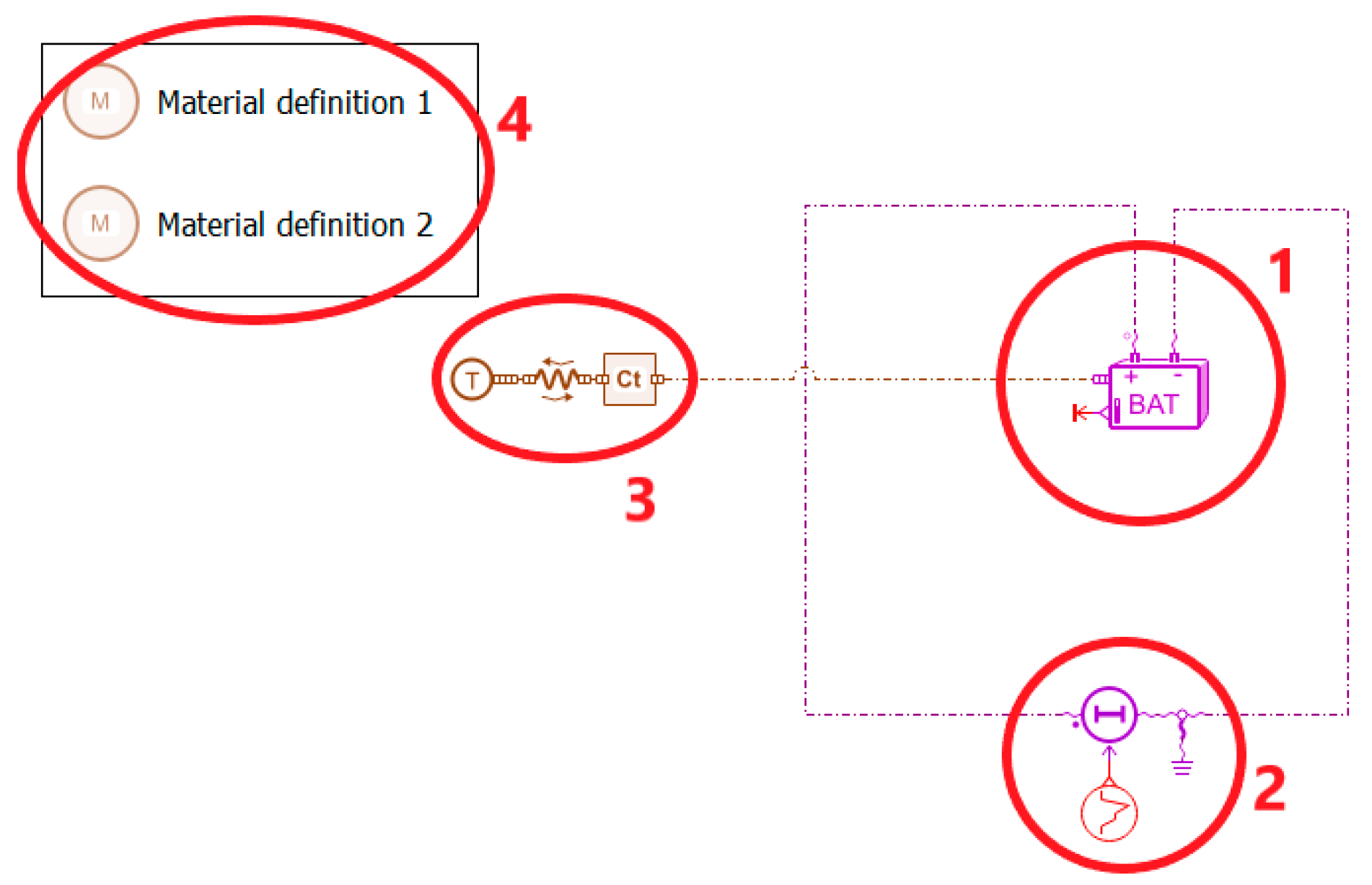
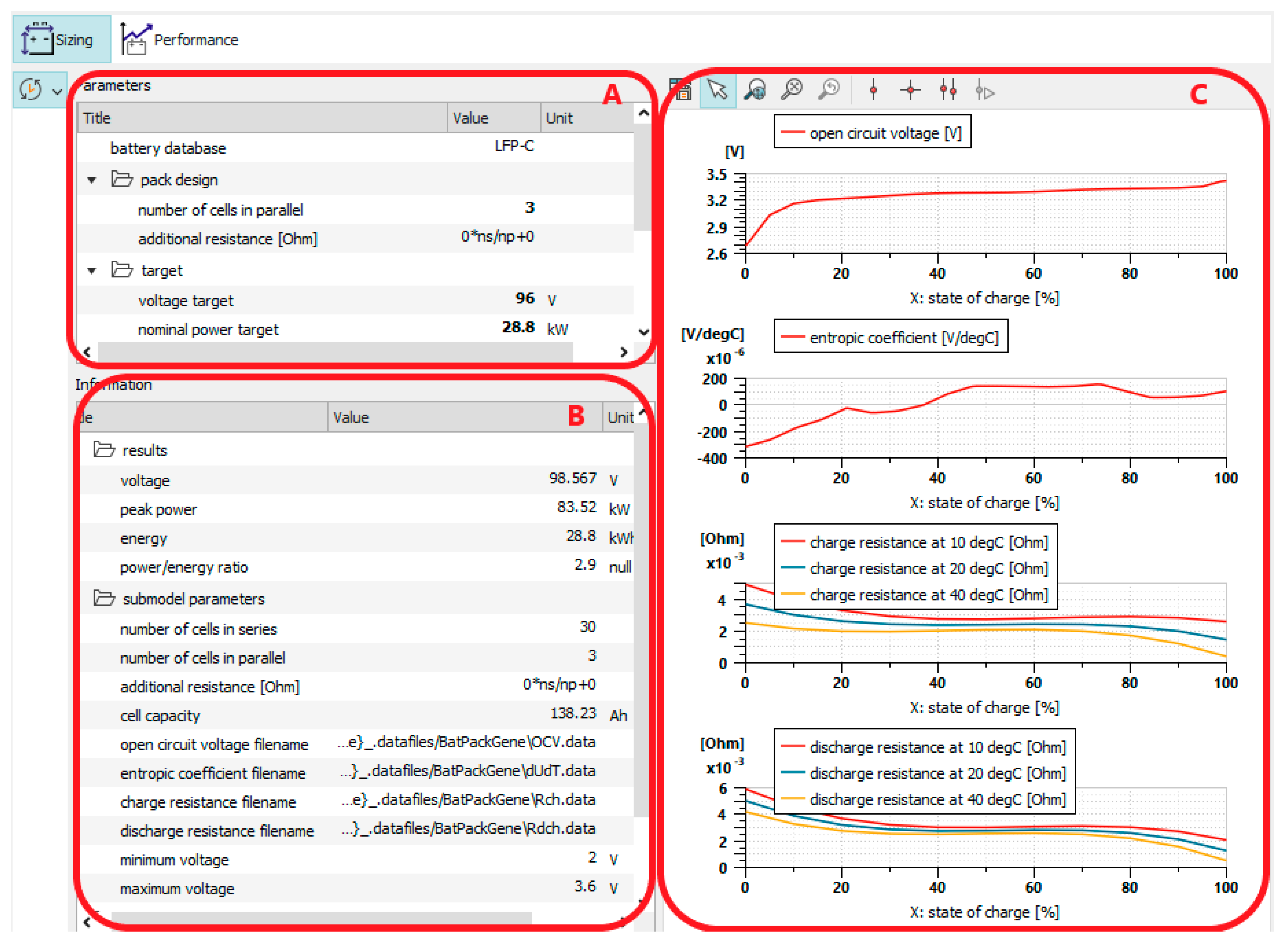
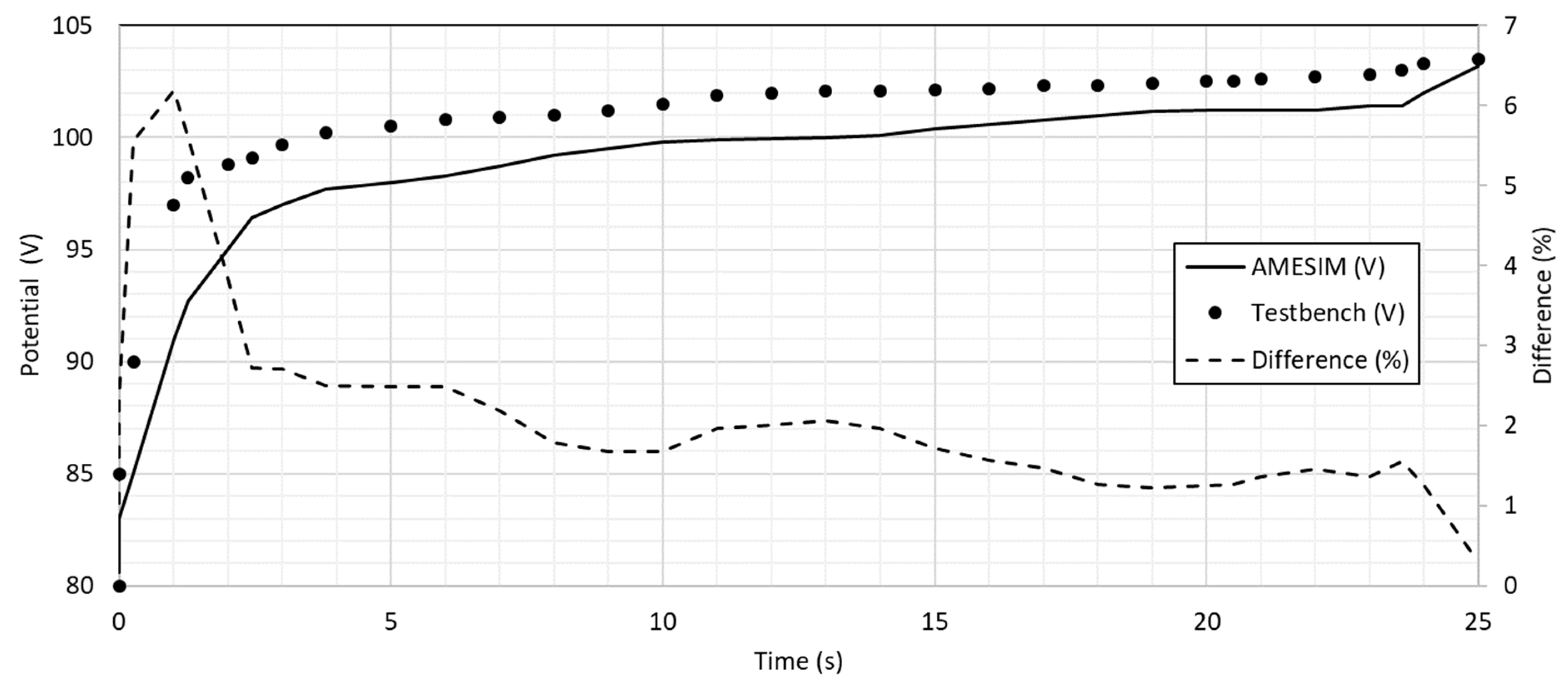
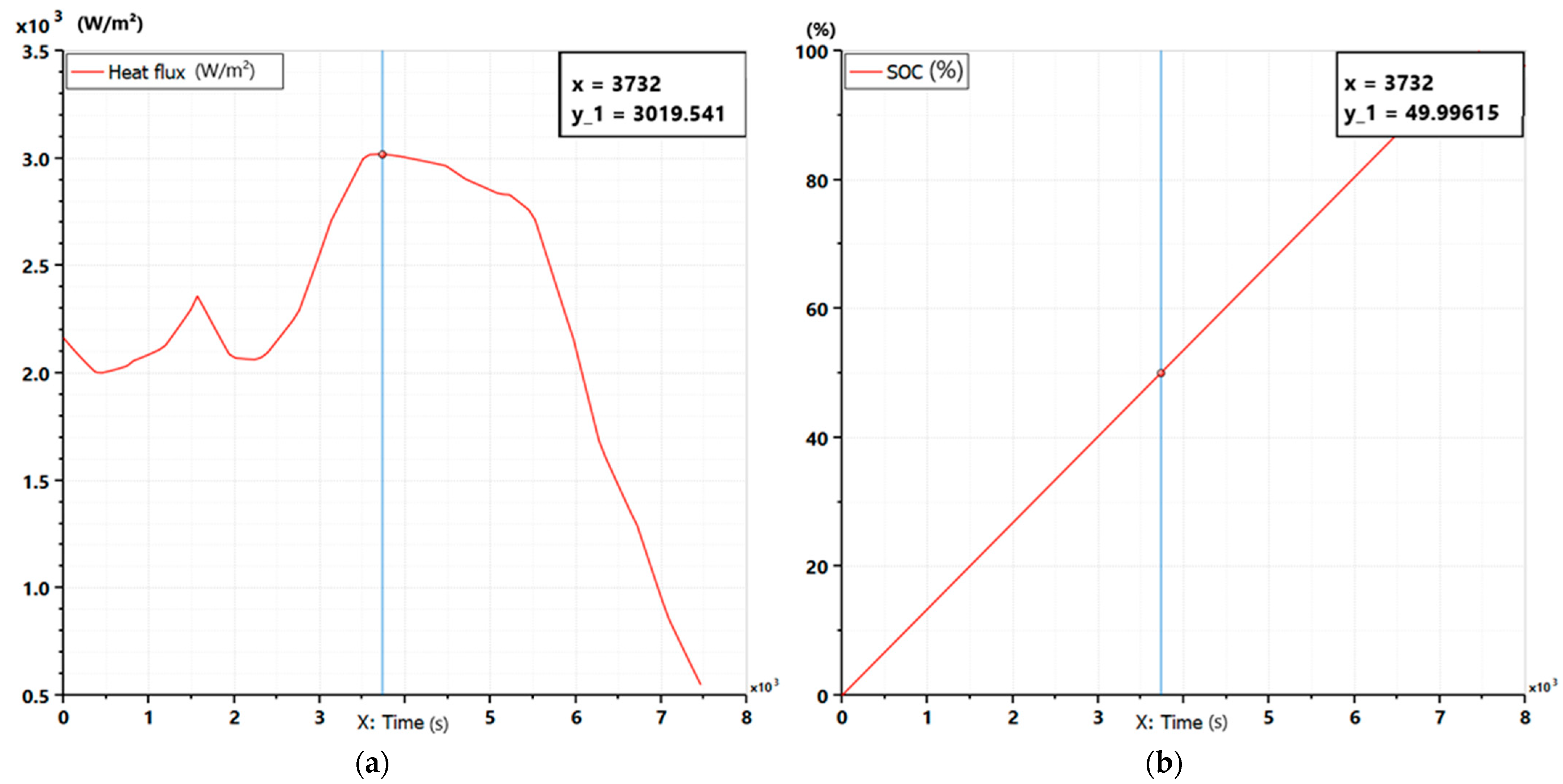
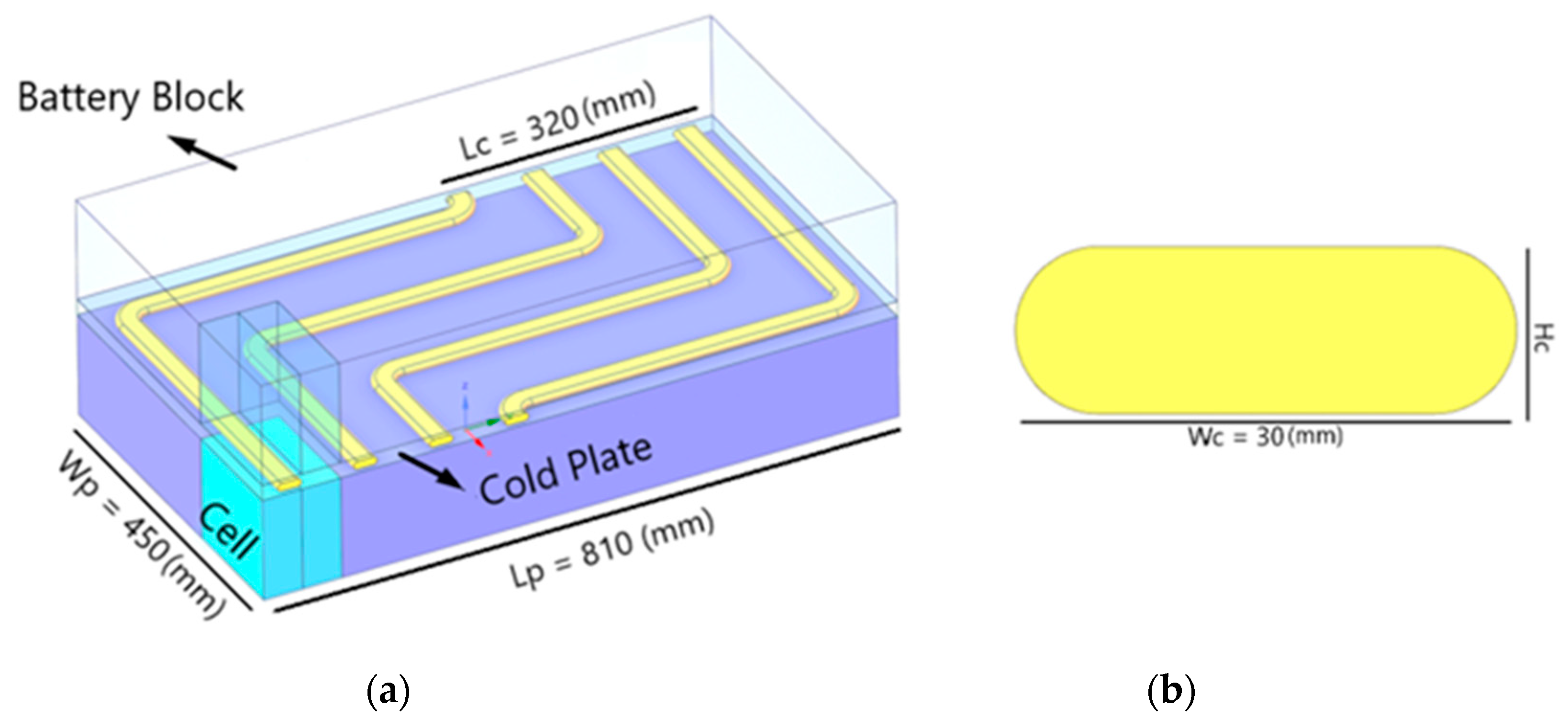
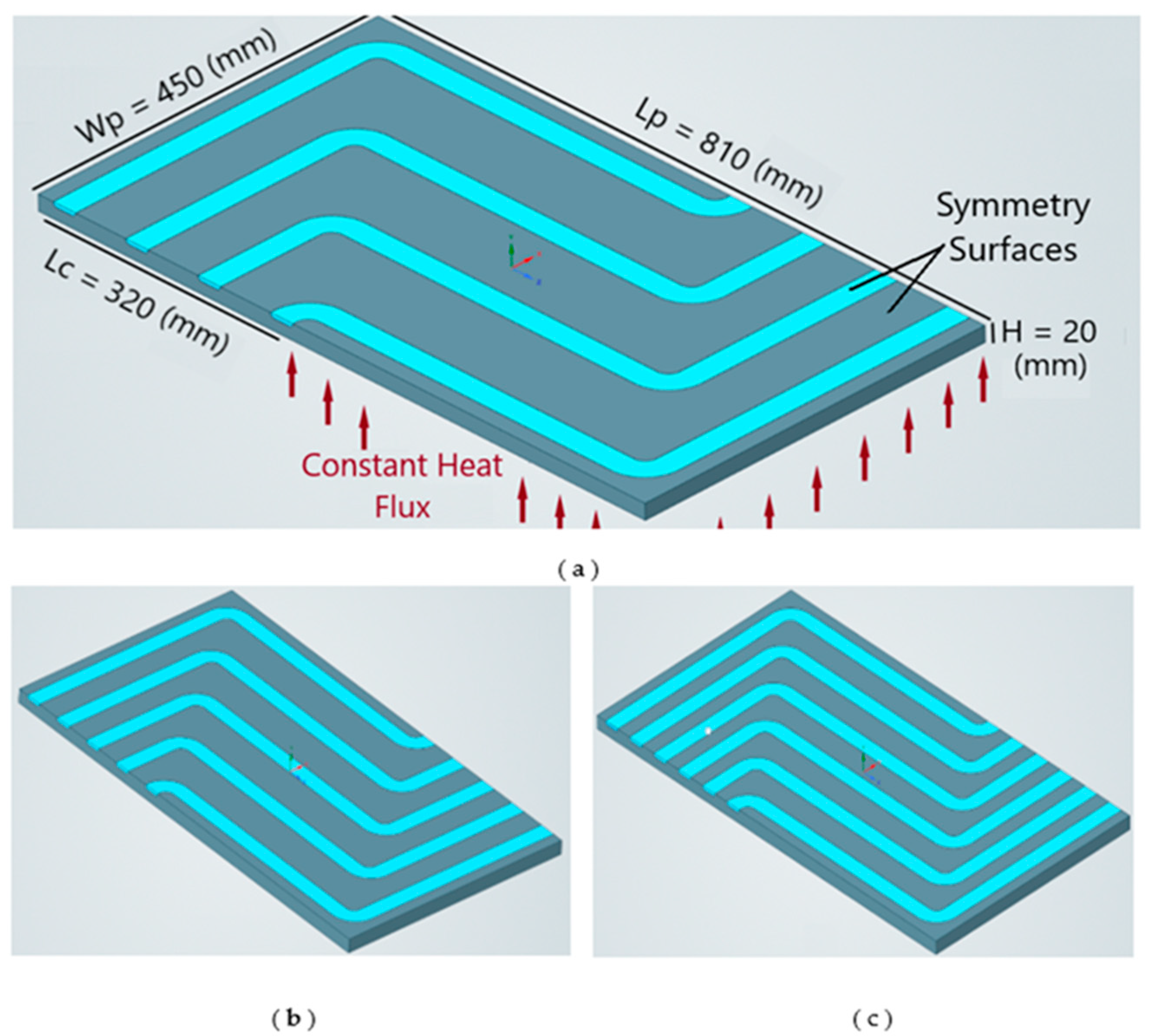
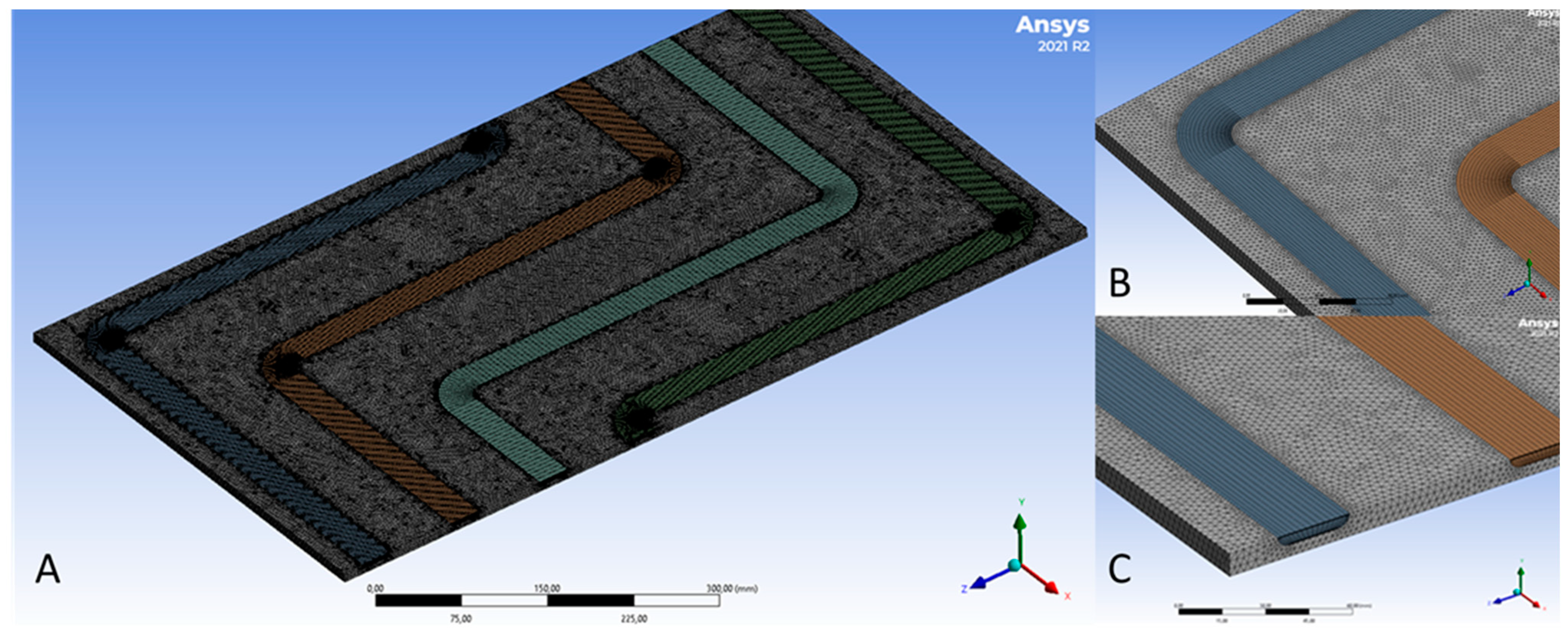
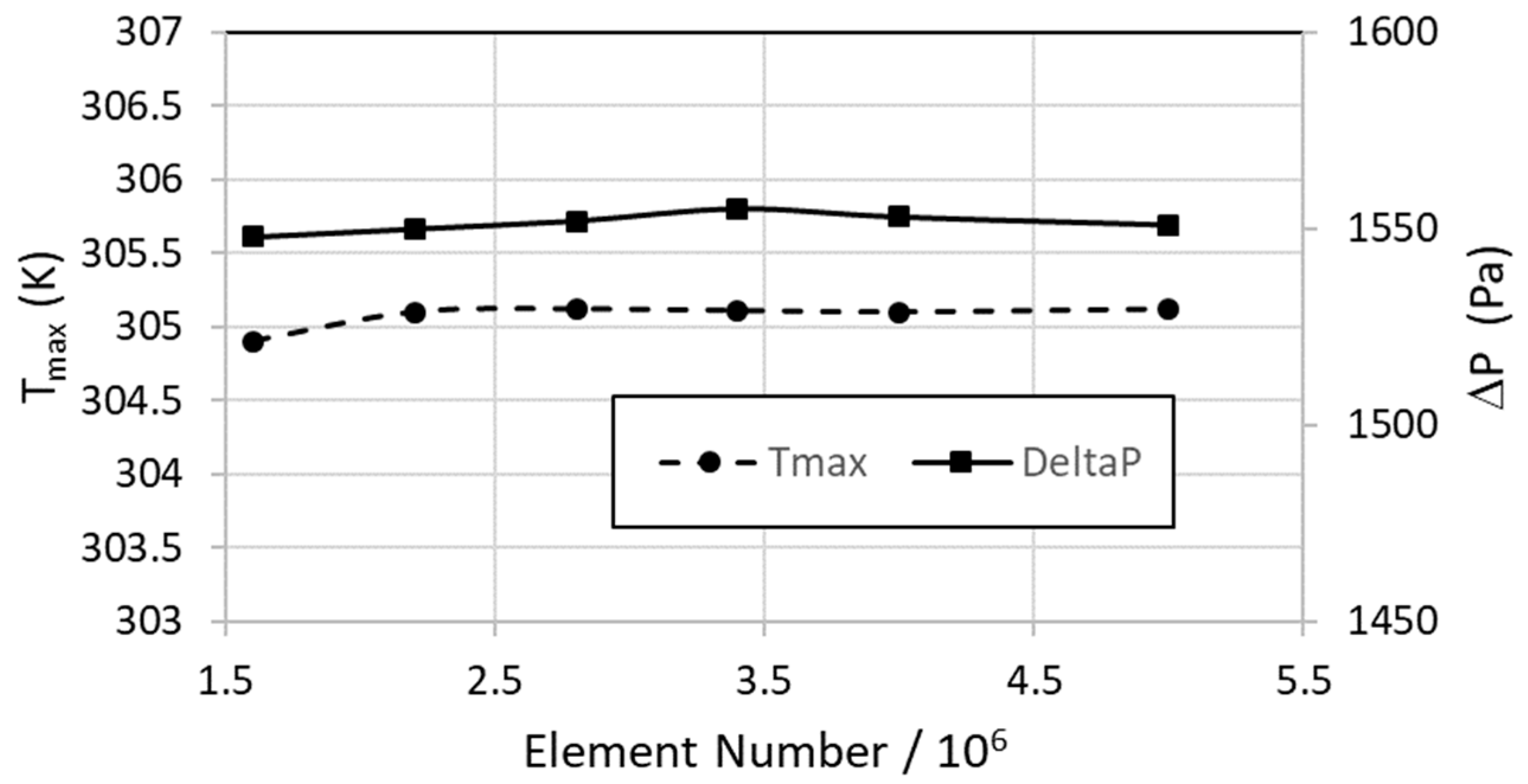
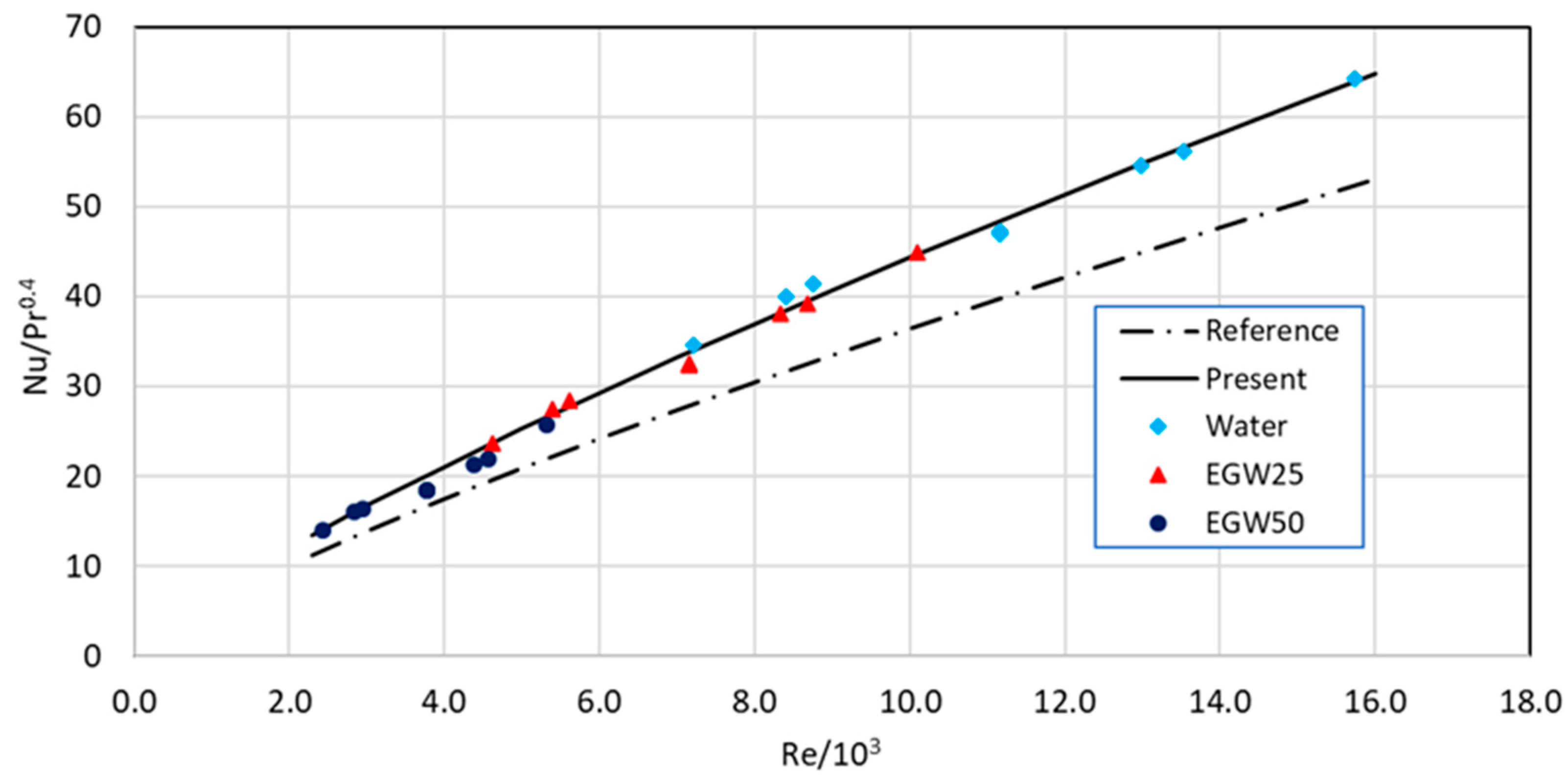
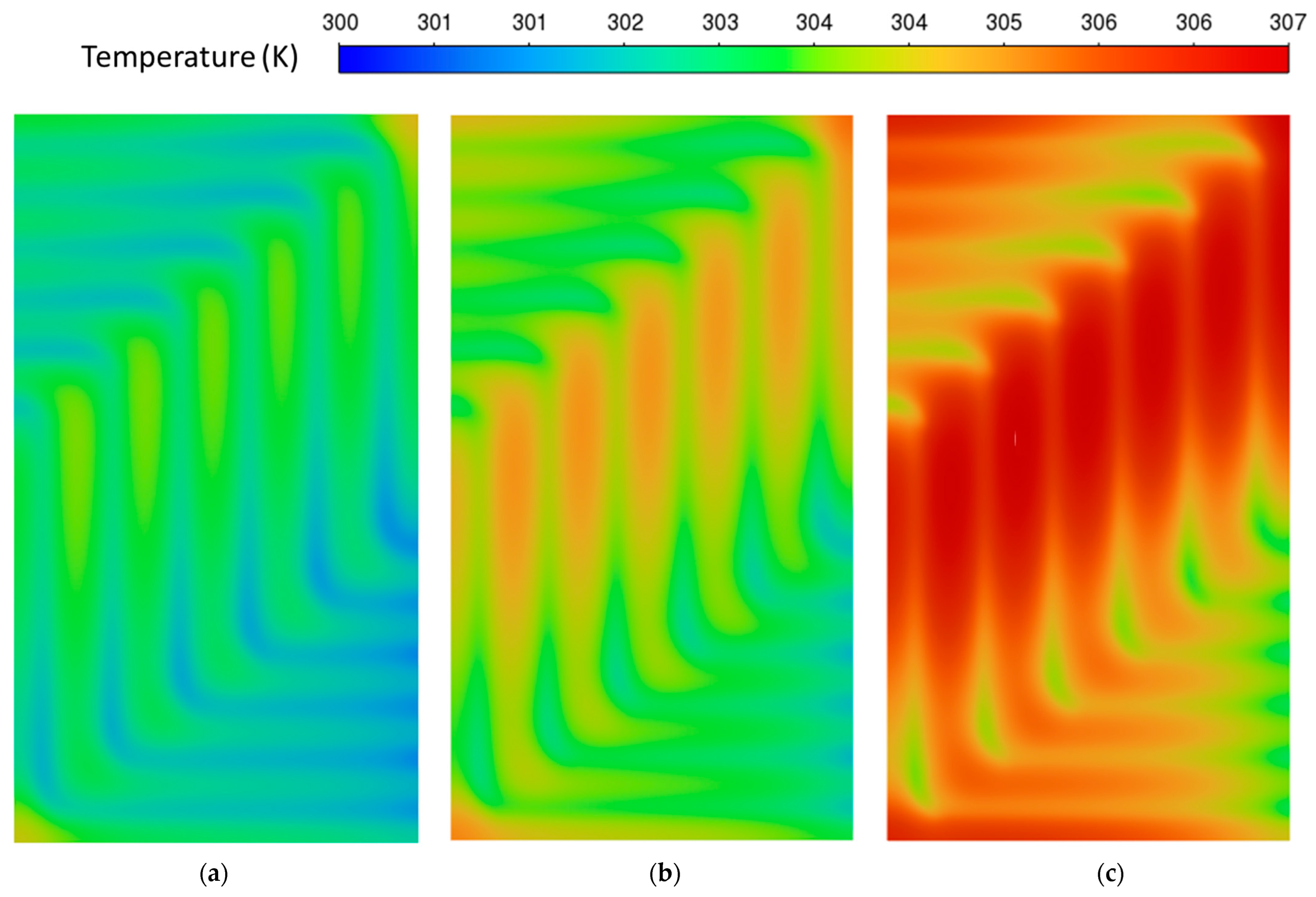
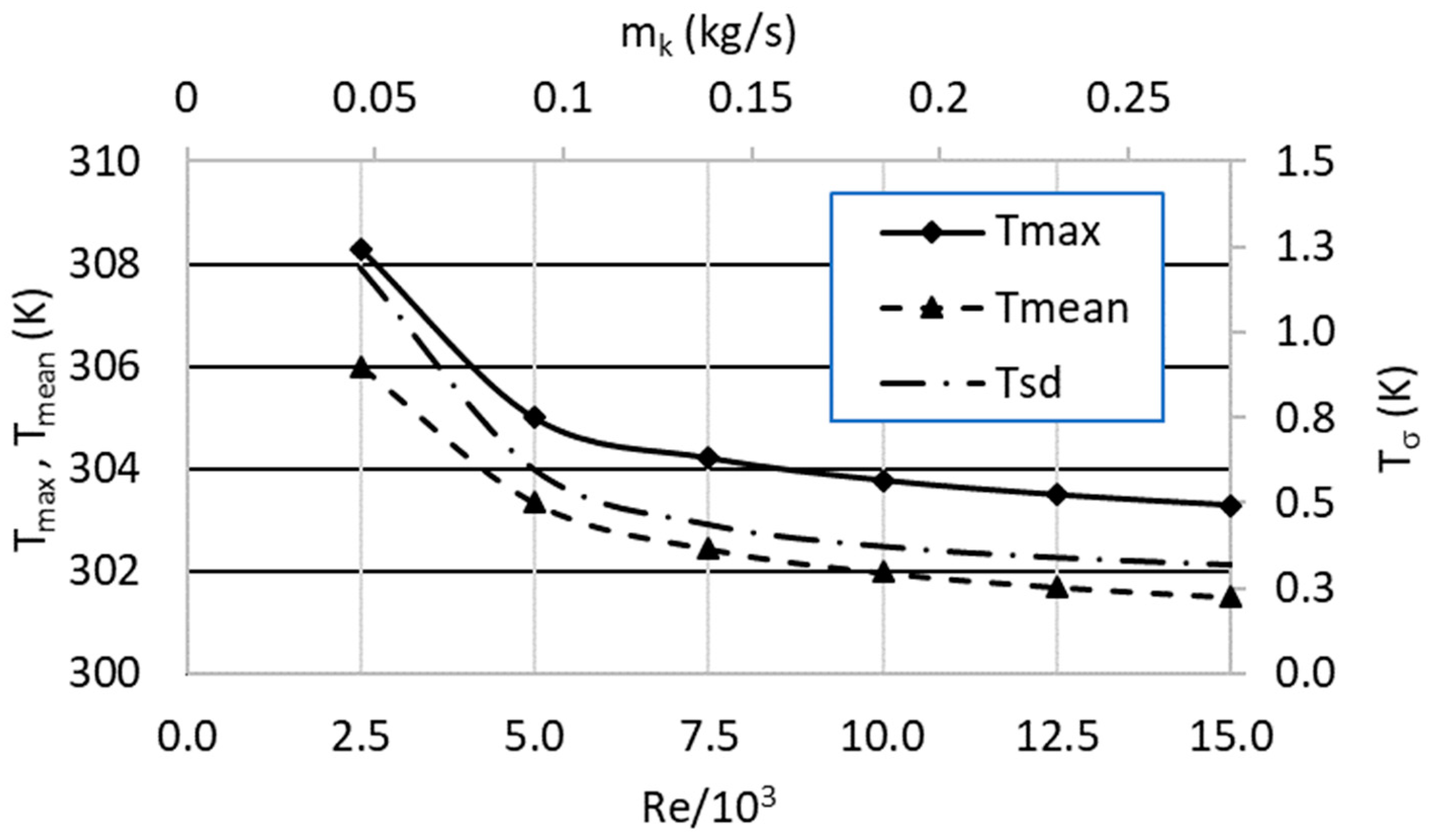
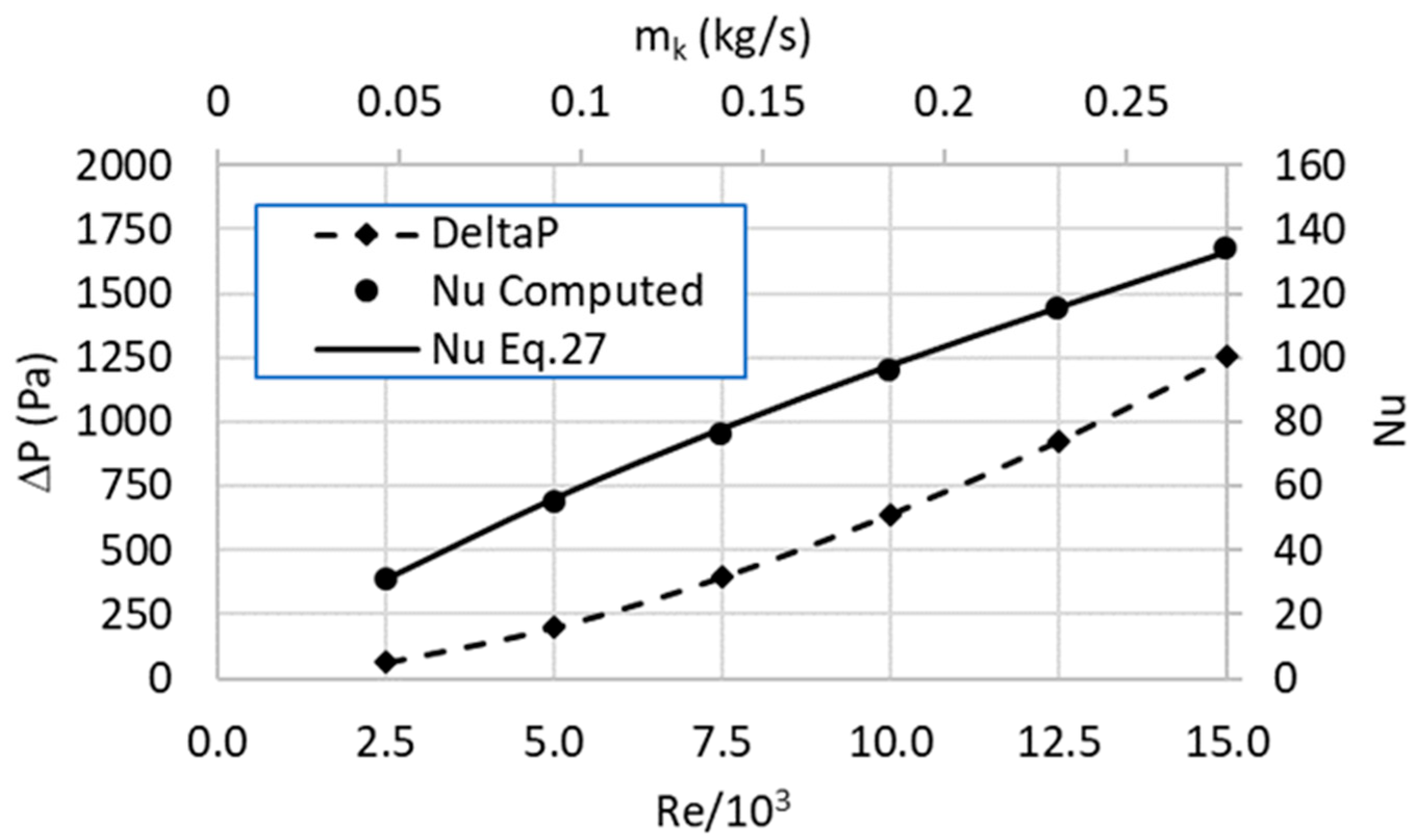

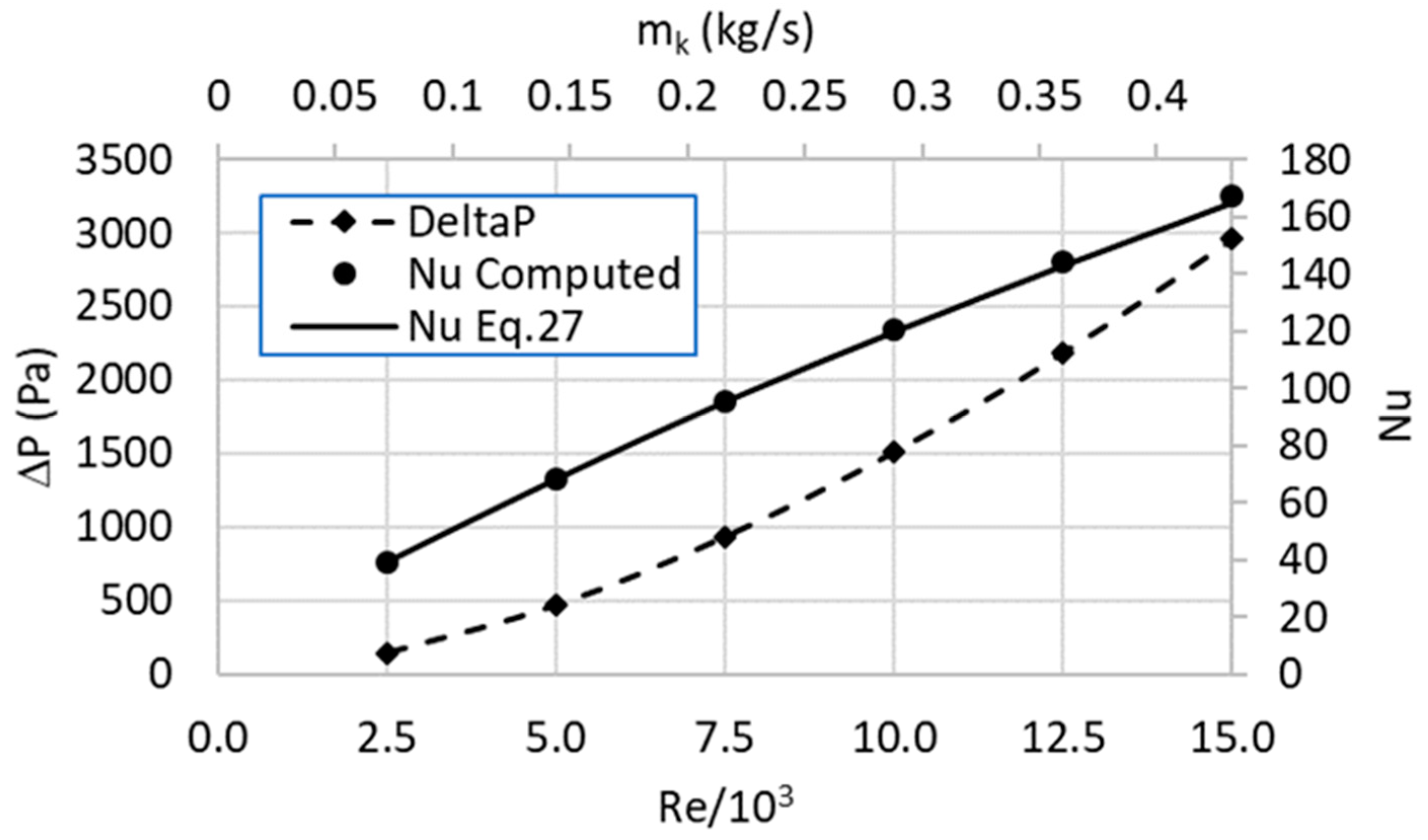
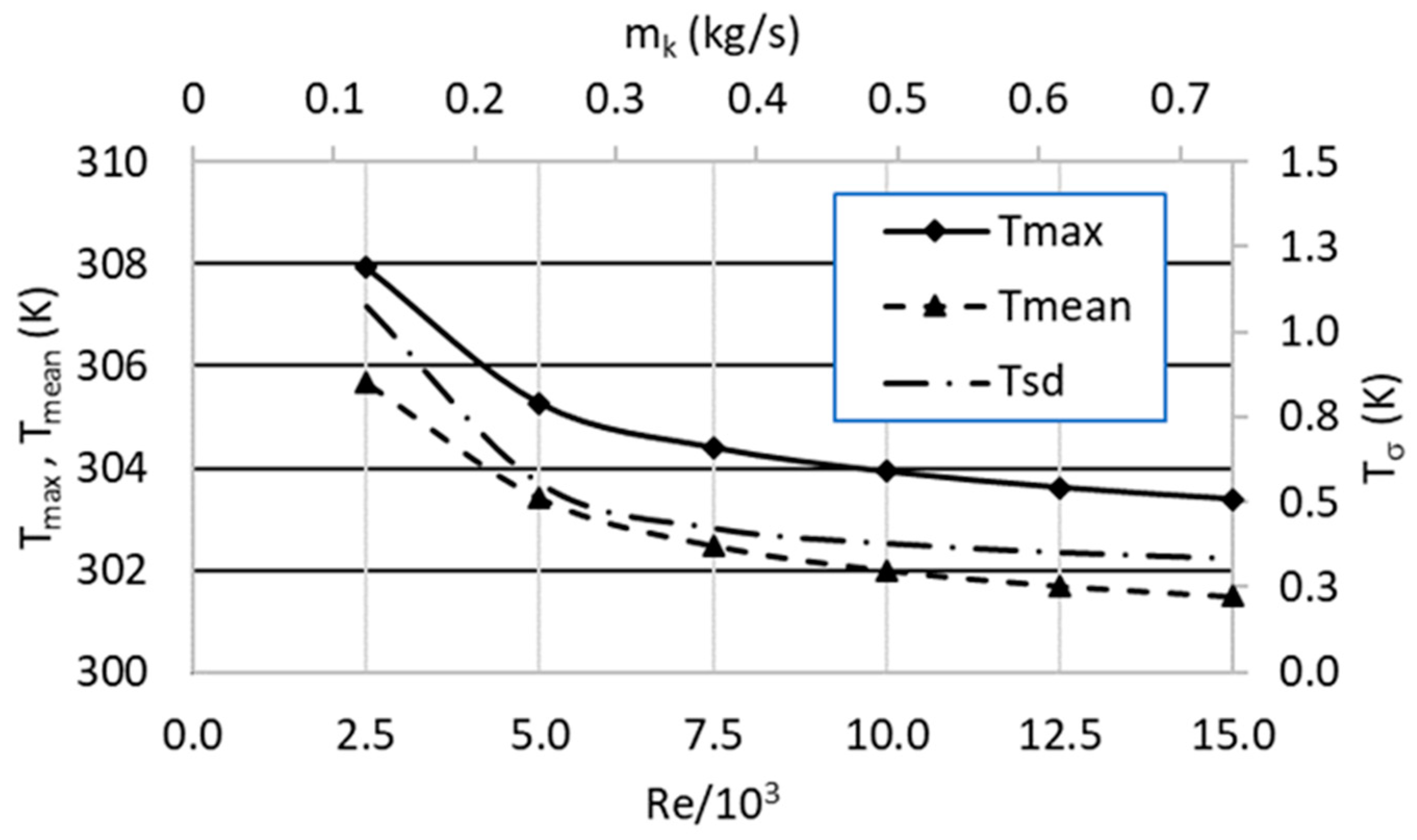
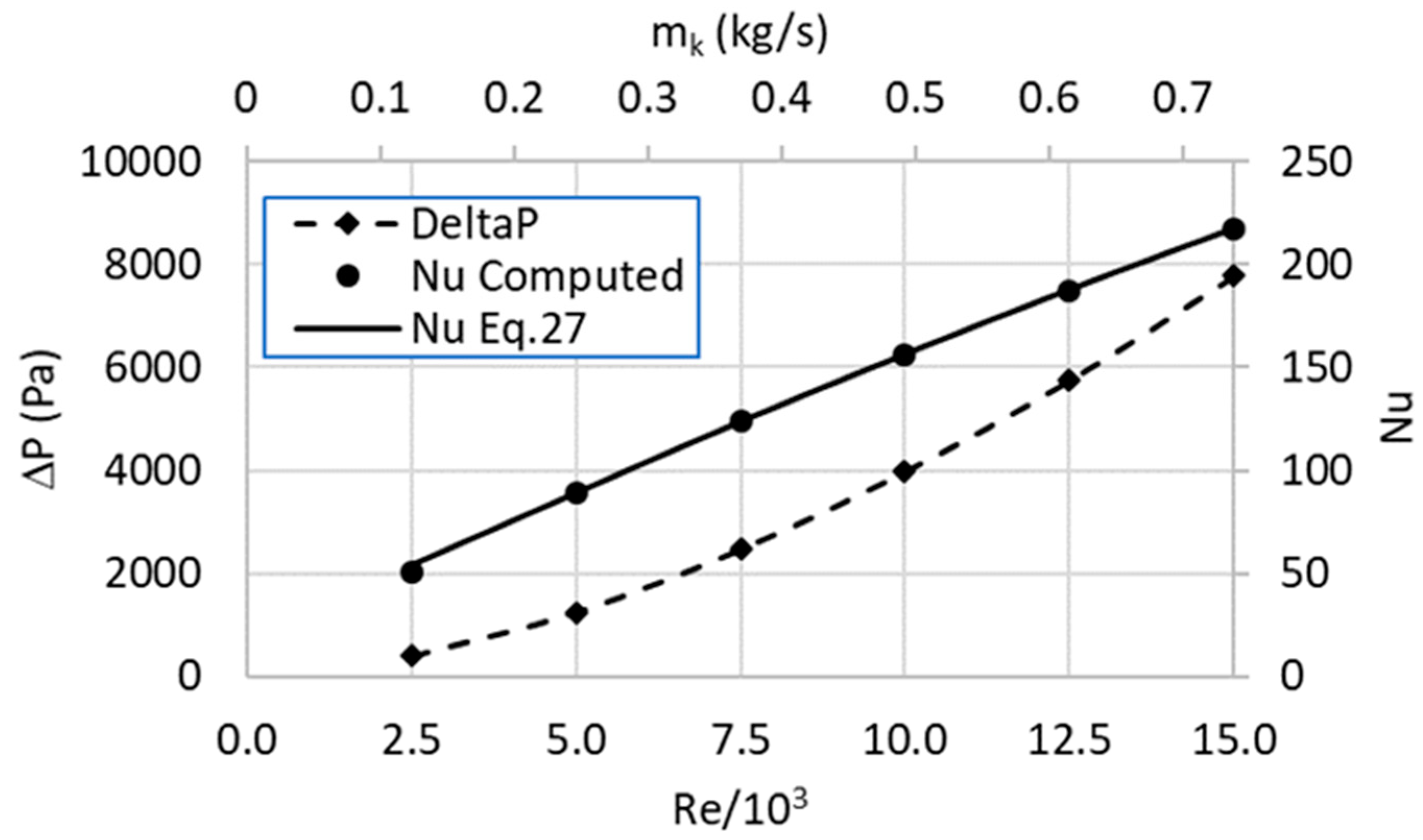
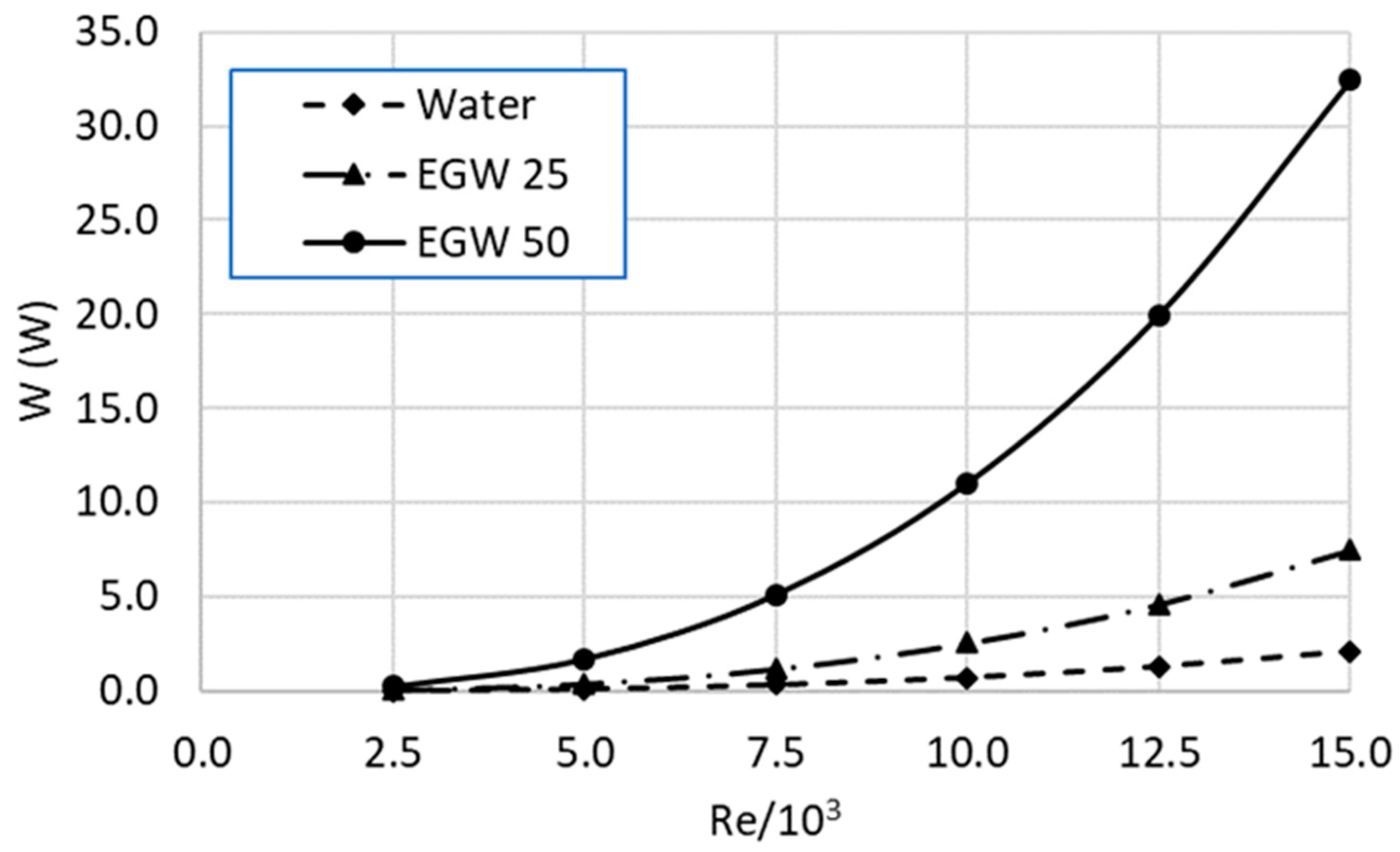
| AMESIM | Measured | Difference (%) | |
|---|---|---|---|
| Average Battery Temperature (°C) | 30.31 | 33.19 | 8.7 |
| Parameters | Coolant | (NOC) Number of Channels | (Hc) Channel Height (mm) | (M) Mass Flow Rate (kg/s) |
|---|---|---|---|---|
| Level 1 | Water | 4 | 10 | 0.8 |
| Level 2 | EGW 25 | 5 | 12 | 1 |
| Level 3 | EGW 50 | 6 | 14 | 1.2 |
| Specifications | Coolant Fluids | Material of the Plate | ||
|---|---|---|---|---|
| Water | EGW 25 | EGW 50 | Aluminum | |
| Density () (kg/m3) | 998.2 | 1028 | 1061 | 2719 |
| Specific heat () (J/kg K) | 4182 | 3827 | 3348 | 871 |
| Heat transfer coefficient (k) (W/mK) | 0.6 | 0.493 | 0.3935 | 202.4 |
| Viscosity (µ) (Ns/m²) | 0.001003 | 0.001564 | 0.002974 | |
| Prandtl Number (Pr) | 6.99 | 12.14 | 23.30 | |
| Freezing temperature (°C) | 0 | −10 | −36 | |
| Factors/ Levels | NOC | Hc | M |
|---|---|---|---|
| 1 | 4 | 10 | 0.8 |
| 2 | 4 | 12 | 1 |
| 3 | 4 | 14 | 1.2 |
| 4 | 5 | 10 | 1 |
| 5 | 5 | 12 | 1.2 |
| 6 | 5 | 14 | 0.8 |
| 7 | 6 | 10 | 1.2 |
| 8 | 6 | 12 | 0.8 |
| 9 | 6 | 14 | 1 |
| Parameter | Present Calculation | Data of Reference [58] | % Difference |
|---|---|---|---|
| Tmean (K) | 306.12 | 306.09 | 0 |
| Tσ (K) | 2.54 | 2.51 | 1.2 |
| ΔP (Pa) | 3007 | 2948 | 2 |
| Reynolds Number | |||||
|---|---|---|---|---|---|
| Levels | Dh | M | Water | EGW 25 | EGW 50 |
| 1 | 0.0156 | 0.8 | 11,168.53 | 7162.43 | 3766.66 |
| 2 | 0.0179 | 1 | 13,528.17 | 8675.68 | 4562.46 |
| 3 | 0.0199 | 1.2 | 15,746.01 | 10,097.98 | 5310.44 |
| 4 | 0.0156 | 1 | 11,168.53 | 7162.43 | 3766.66 |
| 5 | 0.0179 | 1.2 | 12,987.05 | 8328.65 | 4379.96 |
| 6 | 0.0199 | 0.8 | 8397.87 | 5385.59 | 2832.23 |
| 7 | 0.0156 | 1.2 | 11,168.53 | 7162.43 | 3766.66 |
| 8 | 0.0179 | 0.8 | 7215.03 | 4627.03 | 2433.31 |
| 9 | 0.0199 | 1 | 8747.78 | 5609.99 | 2950.24 |
| Parameters/Arrays | Water | EGW25 | EGW50 | |||||||||
|---|---|---|---|---|---|---|---|---|---|---|---|---|
| Tmax (K) | Tmean (K) | Tσ | ∆P (Pa) | Tmax (K) | Tmean (K) | Tσ | ∆P (Pa) | Tmax (K) | Tmean (K) | Tσ | ∆P (Pa) | |
| L1 | 305.44 | 303.36 | 1.02 | 1099.20 | 306.54 | 304.34 | 1.10 | 1229.84 | 309.30 | 306.50 | 1.34 | 1444.32 |
| L2 | 305.23 | 303.19 | 1.03 | 1050.27 | 306.24 | 304.06 | 1.10 | 1185.10 | 308.80 | 306.11 | 1.30 | 1396.90 |
| L3 | 305.13 | 303.07 | 1.03 | 1009.82 | 306.10 | 303.89 | 1.10 | 1140.10 | 308.36 | 305.73 | 1.28 | 1361.86 |
| L4 | 303.58 | 302.37 | 0.54 | 1096.83 | 304.44 | 303.14 | 0.60 | 1227.72 | 306.65 | 304.86 | 0.82 | 1441.14 |
| L5 | 303.51 | 302.28 | 0.54 | 978.00 | 304.30 | 302.98 | 0.60 | 1104.75 | 306.41 | 304.67 | 0.77 | 1303.57 |
| L6 | 304.55 | 303.12 | 0.63 | 355.46 | 305.93 | 304.23 | 0.75 | 398.72 | 309.07 | 306.58 | 1.14 | 473.66 |
| L7 | 303.47 | 301.85 | 0.36 | 1109.72 | 304.07 | 302.49 | 0.42 | 1244.48 | 305.30 | 303.94 | 0.64 | 1456.62 |
| L8 | 304.28 | 302.64 | 0.45 | 371.34 | 305.14 | 303.65 | 0.59 | 412.44 | 307.67 | 305.69 | 1.05 | 493.58 |
| L9 | 304.18 | 302.40 | 0.43 | 384.53 | 305.00 | 303.29 | 0.54 | 430.71 | 306.99 | 305.22 | 0.91 | 508.71 |
| Tmax | Tσ | ∆P | ||||||
|---|---|---|---|---|---|---|---|---|
| Water | EGW25 | EGW50 | Water | EGW25 | EGW50 | Water | EGW25 | EGW50 |
| −49.6985 | −49.7297 | −49.8075 | −0.1720 | −0.8279 | −2.5688 | −60.8216 | −61.797 | −63.1933 |
| −49.6927 | −49.7212 | −49.7935 | −0.2207 | −0.8279 | −2.2459 | −60.4260 | −61.4751 | −62.9033 |
| −49.6897 | −49.7173 | −49.7812 | −0.2369 | −0.8279 | −2.1504 | −60.0849 | −61.1389 | −62.6827 |
| −49.6454 | −49.6700 | −49.7328 | 5.3727 | 4.4370 | 1.7486 | −60.8028 | −61.782 | −63.1741 |
| −49.6434 | −49.6660 | −49.7261 | 5.3334 | 4.4370 | 2.2409 | −59.8068 | −60.8653 | −62.3027 |
| −49.6733 | −49.7124 | −49.8010 | 3.9548 | 2.4988 | −1.1452 | −51.0158 | −52.0134 | −53.5094 |
| −49.6423 | −49.6595 | −49.6945 | 8.7577 | 7.5350 | 3.9292 | −60.9042 | −61.8998 | −63.2669 |
| −49.6654 | −49.6900 | −49.7618 | 6.9224 | 4.5830 | −0.3849 | −51.3954 | −52.3072 | −53.8671 |
| −49.6627 | −49.6860 | −49.7426 | 7.3225 | 4.7314 | 0.8508 | −51.6985 | −52.6838 | −54.1295 |
| Tmax | |||||||||
| Water | EGW 25 | EGW 50 | |||||||
| NOC | Hc | M | NOC | Hc | M | NOC | Hc | M | |
| 1 | −49.69 | −49.66 | −49.68 | −49.723 | −49.686 | −49.711 | −49.79 | −49.74 | −49.79 |
| 2 | −49.65 | −49.67 | −49.67 | −49.683 | −49.692 | −49.692 | −49.75 | −49.76 | −49.76 |
| 3 | −49.66 | −49.68 | −49.66 | −49.678 | −49.705 | −49.681 | −49.73 | −49.77 | −49.73 |
| Delta | 0.04 | 0.01 | 0.02 | 0.044 | 0.019 | 0.03 | 0.06 | 0.03 | 0.06 |
| Rank | 1 | 3 | 2 | 1 | 3 | 2 | 1 | 3 | 2 |
| ΣDelta | 0.07 | 0.093 | 0.15 | ||||||
| w (%) | 0.248405 | 0.331338 | 0.56255 | ||||||
| Tσ | |||||||||
| Water | EGW 25 | EGW 50 | |||||||
| NOC | Hc | M | NOC | Hc | M | NOC | Hc | M | |
| 1 | −0.2099 | 4.6528 | 3.5684 | −0.8279 | 3.7147 | 2.0846 | −2.3217 | 1.0363 | −1.3663 |
| 2 | 4.887 | 4.0117 | 4.1582 | 3.7909 | 2.7307 | 2.7802 | 0.9481 | −0.13 | 0.1178 |
| 3 | 7.6675 | 3.6801 | 4.6181 | 5.6165 | 2.1341 | 3.7147 | 1.465 | −0.815 | 1.3399 |
| Delta | 7.8774 | 0.9727 | 1.0497 | 6.4443 | 1.5806 | 1.6301 | 3.7868 | 1.8513 | 2.7062 |
| Rank | 1 | 3 | 2 | 1 | 3 | 2 | 1 | 3 | 2 |
| ΣDelta | 9.8998 | 9.655 | 8.3443 | ||||||
| w (%) | 35.13084 | 34.3986 | 31.2939 | ||||||
| ∆P | |||||||||
| Water | EGW 25 | EGW 50 | |||||||
| NOC | Hc | M | NOC | Hc | M | NOC | Hc | M | |
| 1 | −60.44 | −60.84 | −54.41 | −61.47 | −61.83 | −55.37 | −62.93 | −63.21 | −56.86 |
| 2 | −57.21 | −57.21 | −57.64 | −58.22 | −58.22 | −58.65 | −59.66 | −59.69 | −60.07 |
| 3 | −54.67 | −54.27 | −60.27 | −55.63 | −55.28 | −61.3 | −57.09 | −56.77 | −62.75 |
| Delta | 5.78 | 6.58 | 5.85 | 5.84 | 6.55 | 5.93 | 5.84 | 6.44 | 5.89 |
| Rank | 3 | 1 | 2 | 3 | 1 | 2 | 3 | 1 | 2 |
| ΣDelta | 18.21 | 18.32 | 18.17 | ||||||
| w (%) | 64.62076 | 65.27006 | 68.14355 | ||||||
| Control Factor | Water | EGW 25 | EGW 50 | ||||||
|---|---|---|---|---|---|---|---|---|---|
| Contribution Percentage (%) | |||||||||
| Tmax | Tσ | ∆P | Tmax | Tσ | ∆P | Tmax | Tσ | ∆P | |
| NOC | 76.19 | 96.8 | 30.13 | 64.63 | 89.17 | 30.43 | 48.44 | 60.29 | 30.95 |
| Hc | 6.87 | 1.48 | 38.98 | 10.04 | 5.15 | 38.22 | 11.26 | 12.53 | 37.56 |
| M | 16.69 | 1.68 | 30.89 | 24.52 | 5.41 | 31.34 | 39.99 | 26.26 | 31.48 |
| Error | 0.26 | 0.04 | 0 | 0.81 | 0.27 | 0.01 | 0.31 | 0.92 | 0.01 |
| Total | 100 | 100 | 100 | 100 | 100 | 100 | 100 | 100 | 100 |
| Water | ||||||||
| Analysis | Normalization | Grey Relationship Coefficient | GRG | Arrangement | ||||
| Tmax | Tσ | ΔP | Tmax | Tσ | ΔP | |||
| 1 | 0.014 | 0.000 | 0.012 | 0.336 | 0.333 | 0.336 | 33.626 | 9 |
| 2 | 0.079 | 0.103 | 0.003 | 0.352 | 0.358 | 0.334 | 34.557 | 8 |
| 3 | 0.132 | 0.156 | 0.000 | 0.366 | 0.372 | 0.333 | 35.429 | 7 |
| 4 | 0.017 | 0.945 | 0.738 | 0.337 | 0.901 | 0.656 | 45.054 | 6 |
| 5 | 0.175 | 0.980 | 0.734 | 0.377 | 0.962 | 0.653 | 47.548 | 5 |
| 6 | 1.000 | 0.449 | 0.594 | 1.000 | 0.476 | 0.552 | 84.117 | 3 |
| 7 | 0.000 | 1.000 | 1.000 | 0.333 | 1.000 | 1.000 | 56.919 | 4 |
| 8 | 0.979 | 0.589 | 0.870 | 0.960 | 0.549 | 0.794 | 90.049 | 1 |
| 9 | 0.961 | 0.638 | 0.901 | 0.928 | 0.580 | 0.835 | 89.470 | 2 |
| EGW 25 | ||||||||
| Analysis | Normalization | Grey Relationship Coefficient | GRG | Arrangement | ||||
| Tmax | Tσ | ΔP | Tmax | Tσ | ΔP | |||
| 1 | 0.017 | 0.000 | 0.001 | 0.337 | 0.333 | 0.334 | 33.597 | 9 |
| 2 | 0.070 | 0.122 | 0.000 | 0.350 | 0.363 | 0.333 | 34.412 | 8 |
| 3 | 0.123 | 0.179 | 0.000 | 0.363 | 0.378 | 0.333 | 35.300 | 7 |
| 4 | 0.020 | 0.850 | 0.736 | 0.338 | 0.770 | 0.655 | 44.818 | 6 |
| 5 | 0.165 | 0.908 | 0.740 | 0.375 | 0.844 | 0.658 | 47.361 | 5 |
| 6 | 1.000 | 0.247 | 0.517 | 1.000 | 0.399 | 0.508 | 82.891 | 3 |
| 7 | 0.000 | 1.000 | 1.000 | 0.333 | 1.000 | 1.000 | 56.487 | 4 |
| 8 | 0.984 | 0.566 | 0.749 | 0.969 | 0.536 | 0.666 | 86.305 | 1 |
| 9 | 0.962 | 0.622 | 0.763 | 0.930 | 0.570 | 0.679 | 84.220 | 2 |
| EGW 50 | ||||||||
| Analysis | Normalization | Grey Relationship Coefficient | GRG | Arrangement | ||||
| Tmax | Tσ | ΔP | Tmax | Tσ | ΔP | |||
| 1 | 0.013 | 0.000 | 0.000 | 0.336 | 0.333 | 0.333 | 33.524 | 9 |
| 2 | 0.061 | 0.124 | 0.069 | 0.347 | 0.363 | 0.349 | 34.814 | 8 |
| 3 | 0.096 | 0.234 | 0.089 | 0.356 | 0.395 | 0.354 | 35.588 | 7 |
| 4 | 0.016 | 0.663 | 0.744 | 0.337 | 0.597 | 0.661 | 43.977 | 6 |
| 5 | 0.156 | 0.721 | 0.807 | 0.372 | 0.642 | 0.722 | 48.293 | 5 |
| 6 | 1.000 | 0.058 | 0.287 | 1.000 | 0.347 | 0.412 | 81.238 | 2 |
| 7 | 0.000 | 1.000 | 1.000 | 0.333 | 1.000 | 1.000 | 54.571 | 4 |
| 8 | 0.980 | 0.406 | 0.422 | 0.961 | 0.457 | 0.464 | 80.263 | 3 |
| 9 | 0.964 | 0.576 | 0.618 | 0.933 | 0.541 | 0.567 | 81.649 | 1 |
Disclaimer/Publisher’s Note: The statements, opinions and data contained in all publications are solely those of the individual author(s) and contributor(s) and not of MDPI and/or the editor(s). MDPI and/or the editor(s) disclaim responsibility for any injury to people or property resulting from any ideas, methods, instructions or products referred to in the content. |
© 2023 by the authors. Licensee MDPI, Basel, Switzerland. This article is an open access article distributed under the terms and conditions of the Creative Commons Attribution (CC BY) license (https://creativecommons.org/licenses/by/4.0/).
Share and Cite
Kılıç, M.; Gamsız, S.; Alınca, Z.N. Comparative Evaluation and Multi-Objective Optimization of Cold Plate Designed for the Lithium-Ion Battery Pack of an Electrical Pickup by Using Taguchi–Grey Relational Analysis. Sustainability 2023, 15, 12391. https://doi.org/10.3390/su151612391
Kılıç M, Gamsız S, Alınca ZN. Comparative Evaluation and Multi-Objective Optimization of Cold Plate Designed for the Lithium-Ion Battery Pack of an Electrical Pickup by Using Taguchi–Grey Relational Analysis. Sustainability. 2023; 15(16):12391. https://doi.org/10.3390/su151612391
Chicago/Turabian StyleKılıç, Muhsin, Sevgül Gamsız, and Zehra Nihan Alınca. 2023. "Comparative Evaluation and Multi-Objective Optimization of Cold Plate Designed for the Lithium-Ion Battery Pack of an Electrical Pickup by Using Taguchi–Grey Relational Analysis" Sustainability 15, no. 16: 12391. https://doi.org/10.3390/su151612391
APA StyleKılıç, M., Gamsız, S., & Alınca, Z. N. (2023). Comparative Evaluation and Multi-Objective Optimization of Cold Plate Designed for the Lithium-Ion Battery Pack of an Electrical Pickup by Using Taguchi–Grey Relational Analysis. Sustainability, 15(16), 12391. https://doi.org/10.3390/su151612391







